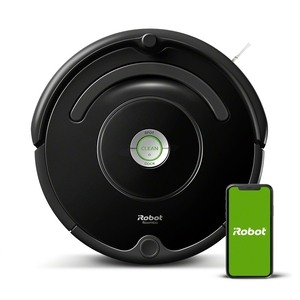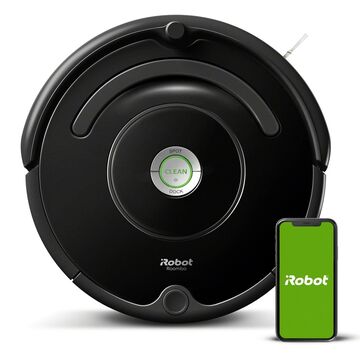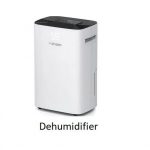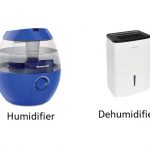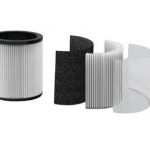Roomba 670 vs 675. Which one does your home need?
If you are anything like me, you probably get yourself worked up when it is time to turn your house upside down chasing the dirt, making sure your house is clean and welcoming. It doesn’t have to be this way, having a clean home doesn’t have to be back-breaking work in addition to taking time out of your busy schedule. Roomba has got you covered. For a pocket-friendly price, you can get your home a well-deserved robot vacuum cleaner to take care of the cleaning and the spills. With one of these robot vacuum cleaners, having a spick and span living space is as simple as clicking a button. Let's get started with the roomba 670 vs 675.
In this article, I’ll tell you all about two robot vacuum cleaners produced by Roomba to make your life easy. Now, it is important to note that these two vacuum cleaners are nearly identical in their performance and the features available. The main differences in the roomba 670 vs 675 resonate around the design and technology built into either robot vacuum cleaners.
It’s for this reason that this article discusses their performance collectively. Any other differences will be clearly stated. Now, about those great features to look out for;
Slim build
Besides the slim build being good for saving space, it serves a special function. The vacuum cleaner is up to a height of 3.6 inches and this means they usually don’t have any difficulties in getting under the furniture to remove the dirt.

High-power batteries
Both vacuum cleaners have high power 1800mAh Lithium-ion batteries that are supercharged to make sure that your vacuum cleaner can run up to 90 minutes uninterrupted. If the living space is moderately small, this might mean that your little vacuum cleaner will need only one cycle to have every space cleaned. For larger spaces, it might need more cycles.
It is important to note that the performance of the vacuum cleaner will vary depending on the level of dirt or presence of heavy carpets as it will require more effort. These are some of the reasons that might lower the 90-minute standard mark. Your robot is not broken if it can’t keep up for 90 minutes. It’s just working harder on the rough spots for your benefit. When the robot cleaner is running low on battery, it will abandon cleaning and return to its base to charge. Each charging cycle will take up to three hours.
Wireless connection and Voice control
Now, this is a very important feature because it can get tiresome manually setting up the vacuum cleaner. Imagine how tiring it would be to follow the robot around as it cleans and pressing a button to tell it to re-clean a spot you are not satisfied with. Might as well get a mop and do the job yourself right?
If your home has a wireless network, you can give your robot instructions. You can set it to start with one click on the mobile app. On this mobile app, you can even receive cleaning reports, set a cleaning schedule of up to seven days and also, your robot will communicate with you in case it is stuck and needs your assistance. One can even make software upgrades to the robot through this app. Being connected through your home network also provides a hustle-free voice control option through Amazon Alexa or Google assistant. Did I mention that you can name your robot? Oh yeah, guess I didn’t. The mobile app provides that option.
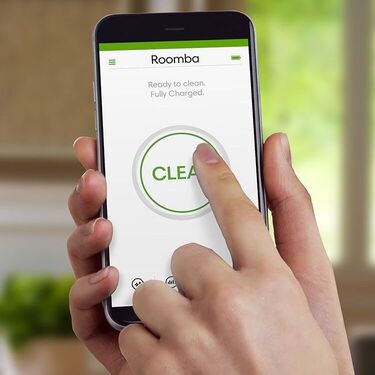
However, if you do not have a wireless network to connect your robot cleaner to, it has a set of local controls that enable you to set it to start cleaning and set it to stop. From this control panel, you can tell its status i.e. if it is charging or not. Red means it is still charging while green means that it is ready to clean.
Navigation and sensors
Both of these vacuum cleaners use the navigation system called iAdapt that mainly uses two types of sensors.
The bump sensors
Since your vacuum cleaner is specially designed to make sure it sweeps over the whole living space picking up dirt and cleaning dirty prints in high traffic spots, it is bound to bump into furniture or your dog maybe. When there is an obstacle in front of the robot, the bump sensors come into play and the robot will slow down to get over the obstacle ahead. If it fails to get over, it will turn around and find another way around the obstacle. This little feature is what saves you from buying a new vacuum cleaner every other week because of crushing accidents.
The drop sensors
The first and most important function of the drop sensors is to save your little cleaning assistant from plummeting over stairs or edges. It senses any drops or edges and stops then changes direction.
Secondly, the drop sensors are the method by which the vacuum cleaners can detect dirt. The drop sensors use infrared light. This light detects the irregularities that characterize a dirty space and the robot cleaner then gets to work.
The Roomba 670 and 675 solely rely on these sensors to make your home clean. They do not have mapping ability or a camera that works as a cleaning aid. The robot cleaner might look like it is simply roaming around aimlessly but it will pick up all the dirt in its path. It is for this reason therefore that the robot vacuum cleaners are unable to remember the state. For example, to start from the last place they cleaned before the battery run low.
The Roomba 675 has special dirt detection technology that senses the dirtier areas depending on your patterns and lifestyle. It then focuses on eliminating stains in these areas whenever it is cleaning. This feature is absent in the Roomba 670. This is one of the main differences between the roomba 670 vs 675.
Cleaning process
Both of these robot cleaners use a 3-step Aero Vac cleaning system to get rid of dirt and debris in your home. This includes the dual multi-surface brush, the edge sweep brush, and vacuum suction that pulls the debris into the bin. The multi-surface brush has two rollers, the first roller collects dirt and lifts it for sucking by the vacuum suction into the chamber.
The second roller is made of rubber. It mostly tries to free the initial brush from debris that gets stuck in the brush’s teeth. The multi-surface brush also automatically adjusts its height to better clean places. For example when cleaning high-rise carpets or throw rugs. The edge sweep brush is responsible for cleaning around corners. However, due to the shape of these vacuum cleaners and the short edge brushes, they might not be able to get all the dust in corners. But they will try their hardest to get most of it. This is still better than most vacuum cleaners.
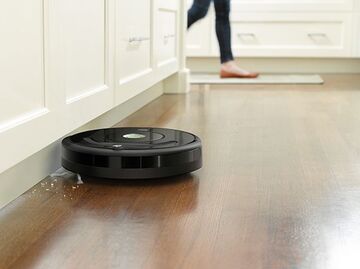
Important to note is that these robot cleaners do not have a HEPA filter. This means that while they might be able to get all particles up to a size of 10 microns, smaller particles might escape the cleaning process.
The Roomba 670 and 675 robot cleaners both have a suction power of 600 Pa (Pascal Pressure Unit) and a noise level of 62 decibels (dB). This noise level is not so loud that it will inconvenience you and put a stop to all other work going on. The Roomba robot cleaners are not as loud as the old-school vacuum cleaners though.
Barriers and containment
Your home might have rooms that you don’t need to be cleaned because they possibly contain delicate content. The Roomba cleaners do not come with virtual barriers. Instead, they are built to be compatible with physical barriers that can be purchased separately. These barriers can be set for the rooms that you don’t want the robot cleaners to access. Also, a more economical solution is to use large objects that are too high for the robot cleaners to get over or around when cleaning.
Smart learning
The robot cleaner will take time to learn your cleaning patterns, which areas get dirtier quicker than others and focus on cleaning these more. Over time, it might even suggest a cleaning pattern for you most especially if your home has pets and it is shedding season.
Warranty
Both of these vacuum cleaners have a 1-year warranty period that covers hardware failures not related to poor usage.
Besides being all-around effective, the Roomba robot cleaners might run into a few issues and this is what you should expect.
- Sometimes, the robot vacuum cleaner might draw all its power out in trying to clean your high-rise carpets or even very dirty parts of the floor and not go up to the expected ninety minutes. This does not mean that it has a defect.
- Also, when the ninety minutes of non-stop cleaning are through, the device is programmed to automatically dock itself and recharge. This might not always be the case; the robot cleaner might run out of battery before making it to its charging base. This is a rare occasion though.
- The vacuum cleaner’s brushes might get hair rolled up in them while trying to clean. To keep up the efficiency, these brushes should be cleaned regularly to get rid of the hair.
Bin Capacity
The Roomba 670 and 675 are reasonably small machines and this means it has a small bin of 300ml capacity. If your home is excessively dirty, this bin will fill up very fast. Sometimes in just one cleaning cycle and therefore has to be emptied often. Instructions on how to empty the bin are always included and well-illustrated in the user’s guide. The filters should also be cleaned often but should never be washed with water. Just tap the filter against a bin or hard surface to free the dust particles in the filter.
Remember for the roomba 670 vs 675, the difference is subtle but can be a game changer for many. Now, we go into the pros and cons of each roomba and we know by the time you reach the conclusion you will be able to make a distinction
Pros of the Roomba 670
- Has two color options to choose from
- Very light and movable (3.6 kgs)
- WIFI and voice control enabled
Roomba 670 Cons
- Does not have a HEPA filter
- Not packaged with virtual barriers
- Doesn’t have the dirt detection technology
- Very small bin
Pros of Roomba 675
- WIFI and voice control enabled
- Has dirt detect technology
- Very light and portable at 3.6 kgs.
Roomba 675 Cons
- Has only a one-color option unlike the Roomba 670
- Very small bin
- No HEPA filter
- Not packaged with virtual barriers
Conclusion of the roomba 670 vs 675
There is no big difference between Roomba 675 and Roomba 670 apart in this post about the roomba 670 vs 675. They have similar performance and cleaning efficiency so you won’t miss many features by choosing one over the other unless you are seriously rooting for a certain color option and specifically need the dirt detection technology.
I would recommend that you go for the Roomba 675 seeing that it has a number of color options to choose from and the dirt detection technology is available.
But If you find one that is cheaper than the other, buy that and it will still meet all your cleaning needs. Both of these robot cleaners are very popular and are highly rated by satisfied users so feel free to try them out.
FREQUENTLY ASKED QUESTIONS
Qn1. How often do I need to empty the Roomba robot vacuum cleaner’s bin?
The bin should be emptied frequently depending on how dirty the house is. So, for example, if your robot cleaner is scheduled to clean twice a week, it should be emptied after its second clean. But again, this all depends on how much debris is in the house.
Qn2. Are Roomba vacuum cleaner filters washable?
These filters are not designed to handle liquids of any kind. This is because the vacuum cleaner charges using electricity so water might cause damage to the filters and the vacuum cleaner too. If the filters are being cleaned, simply shake them hard to remove the debris.
Qn3. How often should I clean my robot cleaner?
It is highly advisable to clean the filters weekly and replace them at least every two months. The edge sensors should be cleaned once each month (these do not need replacing unless they get damaged). The wheels and brushes should also be cleaned weekly and replaced every 12 months.
Other Frequently Asked Questions
Qn4. What is the expected life expectancy of the Roomba 670 or 675?
When well used and maintained, the Roomba iRobot vacuum cleaner will work for 2 to 5 years. This period heavily depends on how you maintain filters and the vacuum cleaner in general. However, some parts are more likely to fail than others and can be replaced instead of discarding the robot cleaner.
Qn5. Does the Roomba 670 or 675 map your house?
Unfortunately, both of these two Roomba robots do not have the technology to map out your house. But the Roomba 675 has the Dirt detectION technology that helps it to detect high traffic spots that usually gather more dirt. It always pay extra attention to these areas when performing a cleaning cycle. These two robots only use their sensors to clean out your house. This doesn’t mean that they are not competent against the other devices with mapping technology.
Featured Posts
Related Posts
- Best Robot Vacuum for Long Hair
- Roborock S5 Max vs S6 MaxV. We help you choose
- Best robot vacuum for vinyl plank floors
- Best robot vacuum for thick carpets and high pile carpets
- The Best robot vacuum under $100
- Roborock s6 vs s6 pure. How different are they?
- Roomba 614 vs 675. Why either might be good for you?
- Roborock s5 vs s6. Deciding Which to Buy?
- Roborock s5 max vs s6. Which is better?
- The Roborock s6 vs Neato d7. Which one should I buy?
- Eufy 30c vs 11s. How do they compare?
- Roborock s5 Vs Roomba i7. Let's compare them
- Eufy 15c vs 30c. Similarities and Differences
- Roomba 675 VS 690. What's the difference?
- Roomba 690 vs 960. Which is better?
- Roomba e6 vs 985. Which one should I pick?
- Roomba 670 vs 690. A useful Irobot Comparison!
